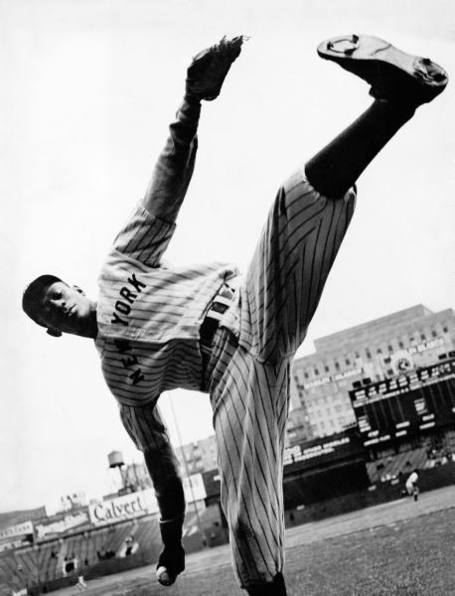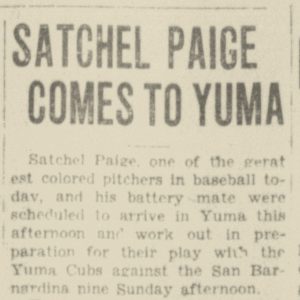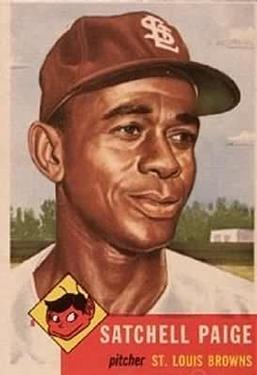
In February 1936 the already legendary Negro League baseball star, Leroy “Satchel” Paige, pitched the Yuma Cubs to victories on two consecutive Sunday afternoons. Paige, who was 29 when he made his first Yuma appearance, returned in 1967 at the age of 61 with a late incarnation of the barnstorming Indianapolis Clowns. And he almost made it to Yuma in 1954 as a member of the Baltimore Orioles’ spring training roster.
The Yuma Cubs and their manager Chris Henderson had crossed paths with Satchel Paige in August 1935 at the inaugural national semi-pro tournament at Wichita, Kansas. The Yuma team was invited by virtue of their winning the Arizona semi-pro championship game over Bisbee, 15-14. Sending the Cubs to Wichita during the lean years of the Depression was a costly endeavor, but Yuma’s merchants generously came up with the needed funds. (And the following year the Cubs changed their name to the Merchants.) Since only six of the Yuma players were able to make the trip, the roster was filled out with players from other Arizona teams. In a 1982 interview Tony Dallabetta, a member of the 1935 team and a long-time Yuma baseball booster, recalled with sadness, “I couldn’t go. I couldn’t get leave from my job.”
The Wichita tournament consisted of 32 teams, including 20 state champions. Other teams included an all-Japanese team from Stockton, California; an all-Native American team from Wewoka, Oklahoma; four all-black teams; and the Stanczak brothers, an all-sibling team from Waukegan, Illinois. It also included the Bismarck Churchills, the North Dakota champions, and their “rented” star pitcher, Satchel Paige. In 1935, while Paige was involved in a contract dispute with the Pittsburgh Crawfords, Bismarck car dealer Neil Churchill hired Paige to pitch for his team. Naturally, the payment included the use of a luxury automobile. While Paige spent the entire summer with the Bismarck team, other African American stars, such as Chet Brewer, were hired solely for the Wichita tournament—which Bismarck won handily thanks to Paige’s four victories and 60 strikeouts.
The Yuma Cubs, who finished a respectable 7th at Wichita, did not draw the Bismarck team in their bracket. However, they did witness firsthand the excitement Satchel Paige created at the tournament. This prompted the Cubs to invite Paige to Yuma six months later.
On Sunday February 9, 1936 the Yuma Cubs were scheduled to host the “powerful” San Bernardino team. When the opponents cancelled on Saturday night, Cubs’ manager Henderson was able to recruit a team of El Centro “all stars” to fill the void. In the Cubs’ 3-1 victory, Satchel Paige was not only the winning pitcher; he also contributed three hits. The Yuma Daily Sun described him as “tall, lanky, awkward and homely,” but also praised his “unbelievable accuracy and speed.” The paper described a scene which Paige was fond of staging at his barnstorming stops: “So sure was Satchel of his hurling that in the last inning he called his teammates in, bunched them around him, and proceeded to strike out the last three men.”
A week later Paige rejoined the Cubs for a game against the “Republic Pictures Baseball Club of Hollywood.” Republic Pictures was an independent “poverty row” studio which specialized in westerns. One of their young stars—movie, not baseball—was named John Wayne. The Republic baseball team, which included former minor leaguers such as pitcher Sid Martin, gave Paige and the Cubs a stiff test on February 16, but Yuma prevailed 2-1 thanks to Satchel Paige’s pitching and his 7th inning double.
After several years with the Kansas City Monarchs, as well as frequent barnstorming appearances against all levels of competition, Satchel Paige finally joined the major league Cleveland Indians in 1948 at the age of 42. This was one year after Jackie Robinson had broken baseball’s “color line” by joining the Brooklyn Dodgers. Owner Bill Veeck, Jr. was a long-time friend and supporter of Paige, so when he sold the Indians and purchased the St. Louis Browns, he again signed Paige to his team. In all, the ageless pitcher spent six seasons in the majors—two with the Indians and four with the Browns. He helped Cleveland win the World Series in 1948, and he made the All-Star team as a Brown in 1953. Shortly after Veeck committed the Browns to spending their 1954 spring training in Yuma, he sold the team to a group of investors from Baltimore—who changed the team’s name to the Orioles. Satchel Paige was on the Orioles preliminary spring training roster that year, but he was released before the team arrived in Yuma. At the age of 47, his major league career was almost over. (He pitched 3 scoreless innings for the Kansas City Athletics in 1965 as a 59 year old!)
 When Satchel Paige returned to Yuma on August 7, 1967, it was as a member of the Indianapolis Clowns. By this time the Clowns were not affiliated with any league, but they carried on as a barnstorming team. In their early years the Clowns combined competitive baseball with showmanship—a teenage Hank Aaron was on the 1952 squad—but by 1967, comedy was the Clowns’ calling card. The Yuma newspaper account indicates that the Indianapolis Clowns defeated the Baltimore Stars in a game that involved a midget, a one-armed first baseman, and an interlude of shadow ball. Sixty-one year old Satchel Paige received the “biggest ovation of the night” when he entered the game in the fourth inning.
When Satchel Paige returned to Yuma on August 7, 1967, it was as a member of the Indianapolis Clowns. By this time the Clowns were not affiliated with any league, but they carried on as a barnstorming team. In their early years the Clowns combined competitive baseball with showmanship—a teenage Hank Aaron was on the 1952 squad—but by 1967, comedy was the Clowns’ calling card. The Yuma newspaper account indicates that the Indianapolis Clowns defeated the Baltimore Stars in a game that involved a midget, a one-armed first baseman, and an interlude of shadow ball. Sixty-one year old Satchel Paige received the “biggest ovation of the night” when he entered the game in the fourth inning.
Satchel Paige was elected to the Baseball Hall of Fame in 1971. His major league win-loss record was a pedestrian 28-31, but these numbers are highly misleading, since segregation in baseball kept him out of the majors until the age of 42—plus he played on some poor St. Louis Browns teams. Paige himself estimated that he won around 2000 total games, including his countless barnstorming appearances in such far-flung locales as Yuma, Arizona. Despite the lack of verifiable statistical evidence, his contemporaries from the Negro Leagues, as well as major leaguers who faced him in exhibition games, universally rated him as one of the best pitchers ever. Baseball fans who saw him pitch would add that he was undoubtedly the most entertaining pitcher ever.
by Jim Patrick, Special Services Librarian


Add a comment to: Now pitching for the Yuma Cubs . . . Satchel Paige!